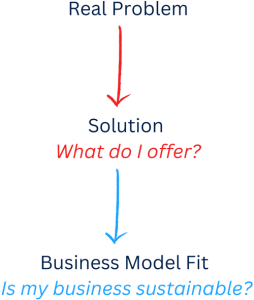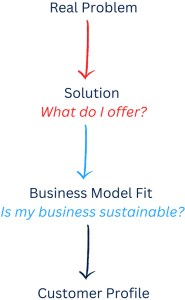
11 Dec Start a Business – Customer Profile
Dec 11, 2024
In the previous publication, we discussed the customer problem you solve, the solution you offer, and whether your business is sustainable enough to cover all your expenses, earn sufficient income, and scale.

We also discovered that none of these three topics make sense if we don’t know who our customer is.
We can invent the most impressive business idea, find a solution, and believe that it will be sustainable. Yet, if we haven’t spoken with at least one potential customer, it simply means we don’t know who we are selling to. Our whole business would be based on impressions, hopes, and most probably incorrect conclusions. The chances of failure are high.
In short, if a business asks you to invest in them or offers you a position as a founder, and you discover that they have never made a simple effort to understand who their customer is and interview them, it’s better to leave that business. They don’t know what they are doing, and most probably they will fail. You will lose your time and money.
What Is a Customer Profile?
This is why today we will undertake one important exercise: you will prepare the profile of your customer. Simply put, the customer profile is a list of features that describe your potential customer, such as age, source of income, education, etc.
Imagine standing on the street. I give you a piece of paper with a list of features and ask you the following:
“Find me a person who corresponds to the features listed here.”
In other words:
The customer profile is a recipe for how to find your customer
Customer vs. User
Be careful not to mistake the customer for the user! Here are two short definitions to provide clarity:
- Customer: The person who buys your product.
- User: The person who uses your product.
These two types of people do not always match. For example, if you sell bottles of mineral water, the person who buys your product is the one who consumes it. In that case, the customer and the user are the same person.
On the other hand, if you sell children’s chocolate, the mother buys the chocolate and she is the customer, but the child is the one who will eat it and therefore is the user. In this particular case, the customer and the user are two different personas.
Remember, we want to prepare the profile of the customer because that is the person who buys our product or service.
Exercise 4:
Identify who your customer is and who your user is.
Customer Profile
For the completion of the fifth exercise, download one of the following templates:
- Download Excel: If you have Microsoft Office or you’d like to work with Google Sheets.
- Download Numbers: If you want to work on a MacBook.
Depending on how many types of customers you have, create a separate column for each group. The next and final step is to fill in the features that describe each customer group. Let’s review each of the features listed in the template file.
Demographics:
- Age: How old is your customer?
- Source of Income: What is the source of income for your customer? This could be a salary, or if your customers are children, they don’t have an income but get money from their parents.
- Field of Occupation: In which industry is your customer working? For example, if your customer is a policeman, the field of occupation is Law Enforcement.
Psychology:
- Education: This is self-explanatory.
- Decision Making: Here you can add anything specific about your customer. For example, they consider every decision carefully or tend to make impulsive decisions.
- Likes / Dislikes: Write down anything that person likes or dislikes.
Behavioural Model / Activities:
- Habits & Skills: This is self-explanatory.
- How Do They Collect Information?: In particular, we are interested in the types of sources of information. This could be TV news, magazines, etc.
- Type of Media Sources: Here we list particular social media channels that the customer uses. For example, LinkedIn.
Environment:
- People: What type of people does your customer communicate with more often? For example, family members, friends, or it could be people from the local bar every night.
- Technologies: Types of technologies your customer uses. For example, email, YouTube.
- Purchasing Power: How much money is your customer able to spend on a monthly basis?
Exercise 5:
Download the templates above and fill in the customer profiles.
What Is Wrong With This Approach?
With the previous exercise, you prepared the profile of your customer. We need that profile to identify your potential customers and interview them. Unfortunately, there is one downside: we are still assuming and guessing who they are.
However, this is the best we can do right now. The next step is to go out and interview our potential customers. These interviews will provide us with much more clarity about our business and who we are selling to.
After we complete the interviews, we will return to this and the previous publications and redo all the exercises. The reason is that we will have a much better understanding of the actual problem we solve, what people need, whether they would buy from us, who they are, and so on.

